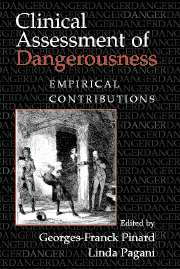Book contents
- Frontmatter
- Contents
- Contributors
- Prologue
- Introduction
- Basic Issues in Violence Research
- Mental Health Issues and Dangerousness
- Family Issues and Dangerousness
- Individual Characteristics and Dangerousness
- Conclusion
- 14 Discussion and Clinical Commentary on Issues in the Assessment and Prediction of Dangerousness
- Index
14 - Discussion and Clinical Commentary on Issues in the Assessment and Prediction of Dangerousness
Published online by Cambridge University Press: 03 July 2009
- Frontmatter
- Contents
- Contributors
- Prologue
- Introduction
- Basic Issues in Violence Research
- Mental Health Issues and Dangerousness
- Family Issues and Dangerousness
- Individual Characteristics and Dangerousness
- Conclusion
- 14 Discussion and Clinical Commentary on Issues in the Assessment and Prediction of Dangerousness
- Index
Summary
This chapter underscores the most salient and clinically pertinent elements of the book. We have chosen to organize this commentary according to components of the standard clinical evaluation process.
Sociodemographic Data
The data invariably suggest that perpetrators of violent acts are more likely to be young, male, single, limited in educational attainment, and from disadvantaged backgrounds. One has to remember that this is a general trend, and practice shows that many offenders do not necessarily correspond to these characteristics.
Medical History
With or without a history of violence, the clinical assessment of dangerousness must involve procedures that rule out organicity. Is there a head injury in the physical history of the individual that may have resulted in brain damage or dysfunction? As mentioned in Chapter 6, physical anomalies of the brain present a greater risk for violence. Of course, this does not rule out the possibility that the inherently aggressive individual placed himself in a situation for possible head injury (i.e., reckless driving, barroom brawls, missed suicide attempts, acts of revenge, etc.).Regardless of your viewpoint on the chicken or egg question, the presence and proper assessment of organicity has true implications for patient evaluation and management (Tardiff, 1992).
Different signs and symptoms with respect to orientation (person, place, time), behavior, affect, and thought and perceptual processes help localize specific cerebral areas of malfunction. Saver, Salloway, Devinsky, and Bear (1996) have described the possible organic causes associated with violent behavior.
- Type
- Chapter
- Information
- Clinical Assessment of DangerousnessEmpirical Contributions, pp. 258 - 278Publisher: Cambridge University PressPrint publication year: 2000



